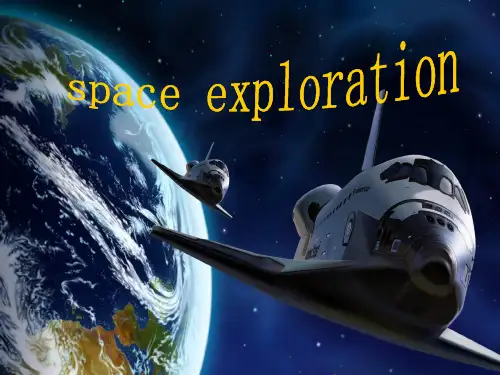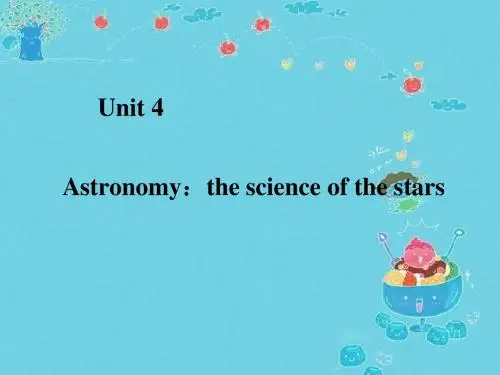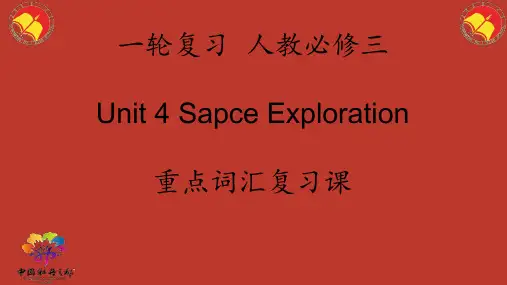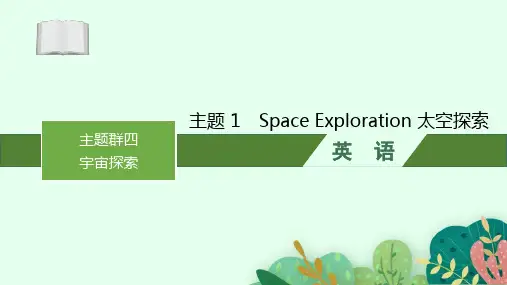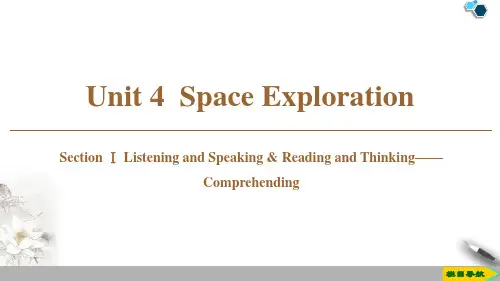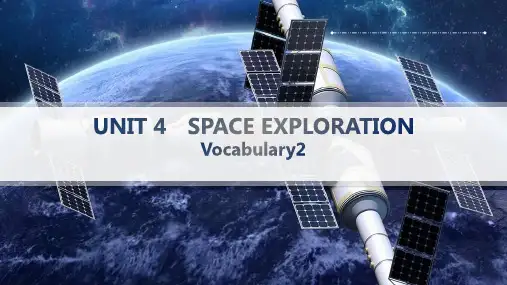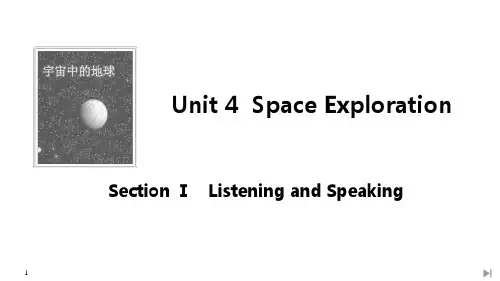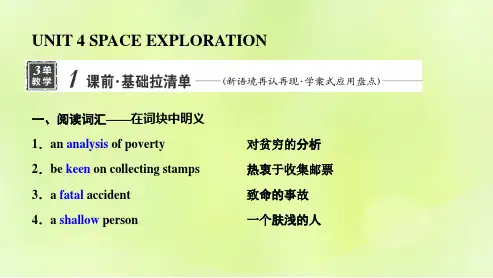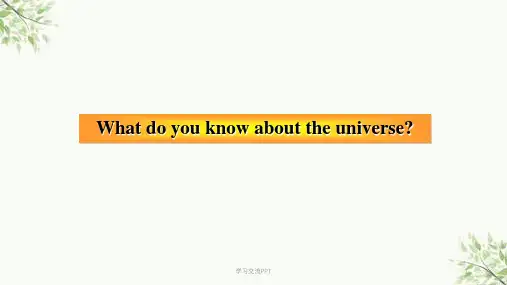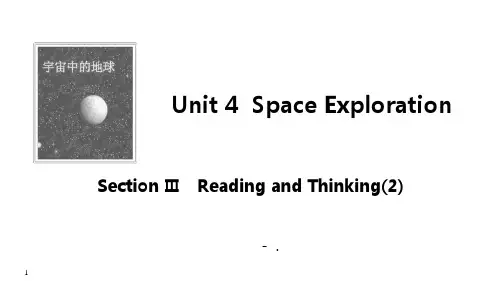太空探索英语PPT
- 格式:ppt
- 大小:3.35 MB
- 文档页数:23
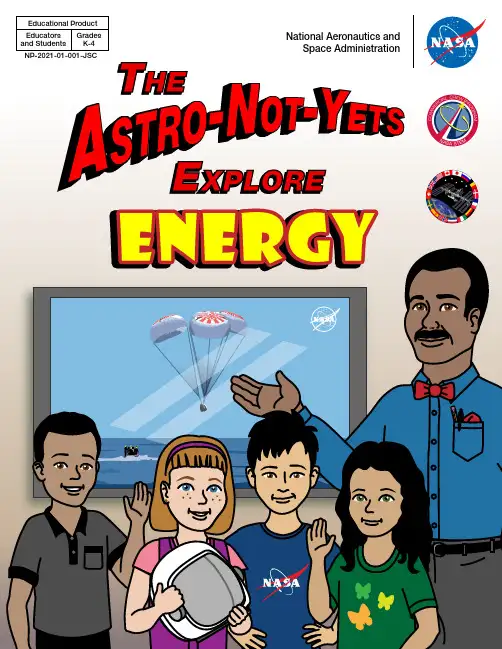
Author: Jessica Sain Illustrator: Cindy Bush Editor: Susan Breedenon their journey to becoming NASA’s future astronauts.Suited to extremes, a 50 year legacy of exploration and achievement continues…National Aeronautics andSpace AdministrationS tella asked, “If they have to launch from the ground to get to the space station, how do they plan to get home?” Mr. Armstrong looked at the class and stated, “That’s a great question, Stella. Does anyone have any ideas for how astronauts might come back down to Earth from 250 miles above the surface?”Leo raised his hand and said, “I bet they land like an airplane on a runway!”Several of the students nodded in agreement. Mr. Armstrong pointed to a poster of the new spacecraft in which the astronauts were traveling and said, “That is a great guess, Leo! When astronauts flew on the Space Shuttle, they did land a lot like an airplane. Now that astronauts travel in these new spacecraft, they use a different method.”of what they use to help them land!”Mr. Armstrong smiled. “I bet you are right, Aurora. You all are great engineers and always come up with creative solutions to different problems.” With NASA TV on in the background — and with the announcer counting down to the landing, one hour away — the Astro-Not-Yets looked to Mr. Armstrong, hoping he would announce an engineering design challenge.A urora raised her hand and exclaimed, “I bet we could all come up with an ideaT o the students’ delight, Mr. Armstrong explained, “Alright Astro-Not-Yets, what do you say we figure out a drop test challenge today while we wait for the landing?” The students cheered and returned to their tables where they awaited details on the challenge.Mr. Armstrong looked at the anxious students and asked, “Does anyone know why we would need something to help with landing? Why can’t the astronauts simply Orion responded, “If they fell, they would be going way too fast to land safely.” “Exactly,” Mr. Armstrong said. “When astronauts travel back through the Earth’s atmosphereto return home, they are slowing down from almost 17,500 miles per hour! When your parents drive you to school, they are going around 25 miles per hour, so the astronauts are flying extremely fast! Since their spacecraft is traveling at a high speed, the energy is also very high. To land safely, they will need to slow down the spacecraft so that the energy is not very highMr. Armstrong explained. “You may use any combination of items in the makerspace to try and decrease the energy of your egg before it hits the ground.”After the demonstration, students brainstormed the landing system they believed would safely land their own egg. The groups then collected items from the classroom makerspace to begin building their designs.Suited to extremes, a 50 year legacy of exploration and achievement continues…00:34:28W hen the groups completed the construction of their landing systems, Mr. Armstrong asked them to gather on the classroom carpet to go over safety for the drop zone. Before walking students back to the zone, Mr. Armstrong asked, “If we aren’t successful at landing the egg without cracking it, what do we do?” Leo quickly responded. “Make changes, and try again!”Aurora also chimed in. “And if you try again and it doesn’t work, you make more changes!” The Astro-Not-Yets nodded in agreement, knowing that Mr. Armstrong always liked to talkabout the importance of improving their designs and never giving up.Suited to extremes, a 50 year legacy of exploration and achievement continues…Ipsum dipsom.00:22:46P roud of the Astro-Not-Yets’ willingness to test their designs, Mr. Armstrong gathered the students around the roped-off drop zone. Aurora’s group volunteered first with a design that included a cushion of tissue paper bundled on the bottom of the egg. All of the students counted down together “3…2…1…” before Aurora released her group’s egg into the zone. The egg fell quickly to the ground, landing on its side instead of on the cushion. A loud cracking noise followed, and the egg yolk splashed across the drop zone mat.Suited to extremes, a 50 year legacy of exploration and achievement continues…M r. Armstrong lifted what was left of the egg and quickly replaced the mat.“We didn’t have a successful landing with this one, but that’s what testing is all about. Aurora, how about you and your team redesign and meet us back here at the drop zone?”Although disappointed in their first test, Aurora’s group was ready to take on the challenge and quickly returned to the makerspace.Leo and Stella’s group volunteered next. Their design included one big piece of cardboard underneath a cup with the egg nestled inside. Their design moved more slowly to the ground than the previous design.Mr. Armstrong picked up the cup and examined the egg, announcing, “We have our first success!”Suited to extremes, a 50 year legacy of exploration and achievement continues…00:10A fter picking up the last group’s egg, Mr. Armstrong said, “This is an impressivedesign, and was also a success! I am happy to see that your group was thinking outside of the box with a parachute design.”After revisiting the makerspace, Aurora’s group was ready to attempt their egg drop again. Aurora announced to the class, “We thought about how our first try didn’t slow down the speed of the egg, so it hit the ground with a lot of energy. Especially since it didn’t land on our cushion!”2021Suited to extremes, a 50 year legacy of exploration and achievement continues…Ipsum dipsom.A urora revealed their new design, which included both a parachute system anda tissue paper cushion on the bottom. After the students counted down, the egg glided slowly to the ground and had a soft landing on top of the cushion.After everyone regrouped on the carpet, Mr. Armstrong revisited the statement that Orion had made earlier. “If we think about the new spacecraft traveling back to Earth at a fast speed with a ton of energy, how might NASA decrease the energy of the spacecraft before it reaches the Earth’s surface?2223either on the ground or in the water. A series of parachutes help to slow down the high speedand energy of the spacecraft once it gets closer to the Earth’s surface. The Space Shuttle alsoused parachutes in the back to help slow the speed of the shuttle, even though it landed likean airplane.”24252627designs one day, when we grow up?”Suited to extremes, a 50 year legacy of exploration and achievement continues…00:05:1600:00:00T he NASA broadcaster announced the opening of the first group of parachutes for the spacecraft. The class watched in amazement as the parachutes ballooned in the air. To the students’ surprise, another set of four parachutes released from the spacecraft.The students cheered as a design similar to their own slowly drifted down and splashed into the ocean. Once again, the Astro-Not-Yets watched in wonder as the landing proved that their own work with design challenges could one day help improve space travel. In fact, they couldn’t wait until their next classroom design challenge!2829。
